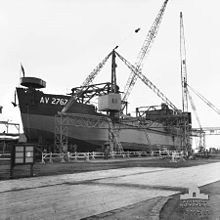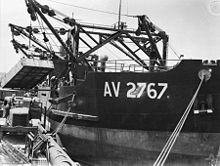Australian Army ship Crusader (AV 2767)
However, the Army did not need a ship with Crusader's capabilities after the war, and she was sold in 1947 to the Queensland Cement and Lime Company which operated her as a coral barge on the Brisbane River until the mid-1980s.During late 1944 and early 1945 the Australian Army suffered from a shortage of shipping, leading to delays in moving heavy equipment and small watercraft from Australia to operational areas in the South West Pacific.Crusader had a shallow draft to allow her to operate close to the shore, as well as four rudders and six engines driving six propellers to give her a high degree of manoeuvrability.[13] She continued to be manned by an Army crew and made several further trips between Tasmania and the mainland, but in April 1947 it was reported that the ship was to be scrapped on the grounds that she was considered unseaworthy.Gil Duthie, the Federal member for Wilmot, sought to have Crusader retained in service until the shortage of shipping capable of transporting heavy loads to and from Tasmania was rectified.[15] The Shipping Control Board rejected Duthrie's representations on the grounds that Crusader would need extensive alterations before she could be permanently used for commercial trade, and it would take at least a year to complete the necessary works.She was subsequently laid up at Mary Street Wharf while attempts were made to sell her; during this period she was renamed Crusader II to avoid confusion with a new ship named Cementco.

Australian ArmyAustralian Shipping BoardQueensland Cement and Lime CompanyWilliamstown DockyardRuston & HornsbyWorld War IIMelbourneTasmaniaBrisbane Riverdive wreckSouth West PacificClive Steelehorsepowersea trialsRabaulNew BritainTorokinaBougainvillePort MoresbyAitapeMadangSydneyLauncestonGil DuthieWilmotEvans DeakinEvans, Anderson, Phelan & Cowheel-houseThe Courier-MailMoreton BayLanding Ship TankHMAS LST 3022Cairncross dry dock1974 Brisbane floodStory BridgeclinkerGladstoneFlinders ReefCape MoretonThe Northern TimesGippsland TimesThe ArgusThe Cairns PostThe MercuryThe ExaminerAustralia in the War of 1939–1945. Series 4 – CivilAustralian amphibious warfare shipsCanberra-class landing helicopter dockCanberraAdelaideBay-class landing shipChoulesRound Table-class landing ship logisticsTobrukKanimbla-class landing platform amphibiousKanimblaManooracatamaranJervis BayBalikpapan-class landing craft heavyBalikpapanBruneiLabuanTarakanSalamauaBetanoLSM-1-class landing ship mediumHarry ChauvelBrudenell WhiteVernon SturdeeLanding Ship Tank (Mark 3)LST 3008LST 3014LST 3022Landing ship, infantryWestraliaRORO shipALC 50Landing Ship Medium Mark IILARC-VLCM2000 classMexefloteList of major warship classes of the Royal Australian NavyShipwrecksCastillo de SalasMikhail LermontovThunderboltUSS GraybackUSS HigbeePride of BaltimoreChian-der 3HMS BerwickAdmiral NakhimovHvalur 6Hvalur 7Kowloon BridgeUSS CaronUSS YorktownRFA CherryleafUSS AtlantaNOAAS FerrelJan HeweliuszUSS Augustaoil spillRecreational dive sitesAkumalAliwal Shoal Marine Protected AreaAliwal ShoalAmed (Bali)Apo IslandApo ReefArrecifes de Cozumel National ParkBay of PigsBelize Barrier ReefBiscayne National ParkBohol SeaBowie SeamountBunakenBunaken National ParkCahuita National ParkCalve IslandCapurganáĊirkewwaCliff Villa PeninsulaCozumelDhilba Guuranda-Innes National Park